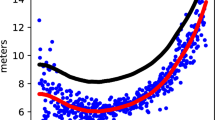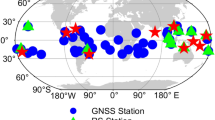Abstract
Global Navigation Satellite System (GNSS) tropospheric tomography is a promising technique to provide high-resolution three-dimensional (3D) water vapor fields for assimilation into weather forecast models. Recently, a novel tomography method based on special mathematical functions, referred to as function-based tropospheric tomography, has been developed. However, this conventional function-based tomography (CFT) method only expresses the water vapor content through a fixed-degree polynomial function in the horizontal direction. This study suggests an adaptive-degree layered function-based tomography (ALFT) approach to overcome the limitation. The novelties of this approach are (1) the establishment of both horizontal and vertical base functions for tomography and (2) the determination of the optimal adaptive degree of the base functions. The proposed method can estimate the atmospheric water vapor at any position and altitude, producing space-continuous atmospheric water vapor distributions. Comparisons against radiosonde and ERA5 data suggest that the ALFT approach yields more accurate solutions than the CFT method, with the root mean square (RMS) error of tomographic results improved by 34% and 33%, respectively. This suggests that the ALFT method may improve the tomographic water vapor products and advance the function-based tomographic technique.











Similar content being viewed by others

Availability of data materials
GNSS data used for this study can be downloaded from the website: http://www.geodetic.gov.hk/sc/rinex/downv.aspx. Radiosonde data and ERA5 data can be downloaded from the website: http://weather.uwyo.edu/upperair/sounding.html and https://cds.climate.copernicus.eu/#!/search?text=ERA5&type=dataset, respectively.
References
Alshawaf F, Hinz S, Mayer M, Meyer F (2015) Constructing accurate maps of atmospheric water vapor by combining interferometric synthetic aperture radar and GNSS observations. J Geophys Res Atmos 120:1391–1403. https://doi.org/10.1002/2014JD022419
Bender M et al (2010) Development of a GNSS water vapour tomography system using algebraic reconstruction techniques. Adv Space Res 47:1704–1720. https://doi.org/10.1016/j.asr.2010.05.034
Benevides P, Catalao J, Nico G, Miranda PMA (2018) 4D wet refractivity estimation in the atmosphere using GNSS tomography initialized by radiosonde and AIRS measurements: results from a 1-week intensive campaign. GPS Solut 22(4):91. https://doi.org/10.1007/s10291-018-0755-5
Bevis M, Businger S, Herring TA, Rocken C, Anthes RA, Ware RH (1992) GPS meteorology: remote sensing of atmospheric water vapor using global positioning system. J Geophys Res Atmos 97:15787–15801. https://doi.org/10.1029/92JD01517
Boehm J, Schuh H (2004) Vienna mapping functions in VLBI analyses. Geophys Res Lett 31:L01603. https://doi.org/10.1029/2003GL018984
Champollion C, Masson F, Bouin M, Walpersdorf A, Doerflinger E, Bock O, Van Baelen J (2005) GPS water vapour tomography: preliminary results from the ESCOMPTE field experiment. Atmos Res 74:253–274. https://doi.org/10.1016/j.atmosres.2004.04.003
Chang L, Xiao R, Prasad AA, Gao G, Feng G, Zhang Y (2019) Cloud mask-related differential linear adjustment model for MODIS infrared water vapor product. Remote Sens Environ 221:650–664. https://doi.org/10.1016/j.rse.2018.12.005
Davis JL, Herring TA, Shapiro II, Rogers AEE, Elgered G (1985) Geodesy by radio interferometry: effects of atmospheric modeling errors on estimates of baseline length. Radio Sci 20(6):1593–1607. https://doi.org/10.1029/RS020i006p01593
Ding N, Zhang S, Wu S, Wang X, Zhang K (2018) Adaptive node parameterization for dynamic determination of boundaries and nodes of GNSS tomographic models. J Geophys Res Atmos 123:1990–2003. https://doi.org/10.1002/2017jd027748
Flores A, Ruffini G, Rius A (2000) 4D tropospheric tomography using GPS slant wet delays. Ann Geophys 18(2):223–234. https://doi.org/10.1007/s00585-000-0223-7
Forootan E, Dehvari M, Farzaneh S, Khaniani AS (2021) A functional modelling approach for reconstructing 3 and 4 dimensional wet refractivity fields in the lower atmosphere using GNSS measurements. Adv Space Res 68(10):4024–4038. https://doi.org/10.1016/j.asr.2021.08.012
Fremouw EJ, Secan JA, Howe BM (1992) Application of stochastic inverse theory to ionospheric tomography. Radio Sci 27(5):721–732. https://doi.org/10.1029/92RS00515
Haji-Aghajany S, Amerian Y, Verhagen S (2020) B-spline function-based approach for GPS tropospheric tomography. GPS Solut 24:88. https://doi.org/10.1007/s10291-020-01005-x
He Q et al (2020) Real-time GNSS-derived PWV for typhoon characterizations: a case study for super Typhoon Mangkhut in Hong Kong. Remote Sens 12(1):104. https://doi.org/10.3390/rs12010104
Howe BM, Runciman K, Secan JA (1998) Tomography of the ionosphere: four-dimensional simulations. Radio Sci 33(1):109–128. https://doi.org/10.1029/97RS02615
Liu C, Zheng N, Zhang K, Liu J (2019a) A new method for refining the GNSS-derived precipitable water vapor map. Sensors 19(3):698. https://doi.org/10.3390/s19030698
Liu W, Lou Y, Zhang W, Huang J, Zhou Y, Zhang H (2019b) On the study of influences of different factors on the rapid tropospheric tomography. Remote Sens 11:1545. https://doi.org/10.3390/rs11131545
Moeller G (2017) Reconstruction of 3D wet refractivity fields in the lower atmosphere along bended GNSS signal paths, Department of Geodesy and Geoinformation, TU Wien, Dissertation. https://doi.org/10.13140/RG.2.2.11617.76647
Nilsson T, Böhm J, Wijaya DD, Tresch A, Nafisi V, Schuh H (2013) Path delays in the neutral atmosphere. In: Atmospheric effects in space geodesy, Böhm J, Schuh H, Eds, Springer Berlin Heidelberg: Berlin, 73–136. https://doi.org/10.1007/978-3-642-36932-2_3
Per CH, Maria S-H (2012) AIR Tools-A MATLAB package of algebraic iterative reconstruction methods. J Comput Appl Math 236(8):2167–2178. https://doi.org/10.1016/j.cam.2011.09.039
Perler D, Geiger A, Hurter F (2011) 4D GPS water vapor tomography: new parameterized approaches. J Geodesy 85:539–550. https://doi.org/10.1007/s00190-011-0454-2
Rohm W (2013) The ground GNSS tomography – unconstrained approach. Adv Space Res 51:501–513. https://doi.org/10.1016/j.asr.2012.09.021
Stoer J, Bulirsch R (1980) Introduction to numerical analysis. Springer, New York. https://doi.org/10.1007/978-1-4757-5592-3
Wu Z, Wang Q, Hu C, Yu Z, Wu W (2022) Modeling and assessment of five-frequency BDS precise point positioning. Satell Navig 3:8. https://doi.org/10.1186/s43020-022-00069-z
Yuan P, Hunegnaw A, Alshawaf F, Awange J, Klos A, Teferle FN, Kutterer H (2021) Feasibility of ERA5 integrated water vapor trends for climate change analysis in continental Europe: an evaluation with GPS (1994–2019) by considering statistical significance. Remote Sens Environ 260:112416. https://doi.org/10.1016/j.rse.2021.112416
Zhang W, Lou Y, Liu W, Huang J, Wang Z, Zhou Y, Zhang H (2020a) Rapid troposphere tomography using adaptive simultaneous iterative reconstruction technique. J Geodesy 94:76. https://doi.org/10.1007/s00190-020-01386-4
Zhang W, Zhang S, Chang G, Ding N, Wang X (2021) A new hybrid observation GNSS tomography method combining the real and virtual inverted signals. J Geodesy 95:128. https://doi.org/10.1007/s00190-021-01576-8
Zhang W, Zhang S, Ding N, Holden L, Wang X, Zheng N (2022) GNSS-RS tomography: retrieval of tropospheric water vapor fields using GNSS and RS observations. IEEE Trans Geosci Remote Sens 60:1–13. https://doi.org/10.1109/TGRS.2021.3077083
Zhang W, Zhang S, Ding N, Ma P (2020b) An improved tropospheric tomography method based on the dynamic node parametrized algorithm. Acta Geodyn Geomater 17(2):191–206
Zhao Q, Yao Y, Yao W (2018) Troposphere water vapour tomography: a horizontal parameterised approach. Remote Sens 10(8):1241. https://doi.org/10.3390/rs10081241
Zhao Q, Liu Y, Yao W, Yao Y (2022) hourly rainfall forecast model using supervised learning algorithm. IEEE Trans Geosci Remote Sens 60:1–9. https://doi.org/10.1109/TGRS.2021.3054582
Acknowledgements
This research was funded by the National Natural Science Foundation of China (grant numbers 42271460, 41974039, and U22A20569).
Author information
Authors and Affiliations
Corresponding authors
Additional information
Publisher's Note
Springer Nature remains neutral with regard to jurisdictional claims in published maps and institutional affiliations.
Rights and permissions
Springer Nature or its licensor (e.g. a society or other partner) holds exclusive rights to this article under a publishing agreement with the author(s) or other rightsholder(s); author self-archiving of the accepted manuscript version of this article is solely governed by the terms of such publishing agreement and applicable law.
About this article
Cite this article
Zhang, W., Zhang, S., Moeller, G. et al. An adaptive-degree layered function-based method to GNSS tropospheric tomography. GPS Solut 27, 67 (2023). https://doi.org/10.1007/s10291-023-01401-z
Received:
Accepted:
Published:
DOI: https://doi.org/10.1007/s10291-023-01401-z



